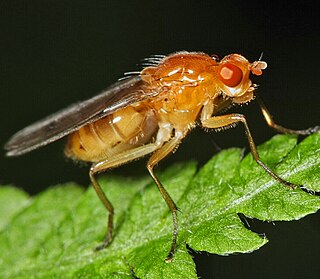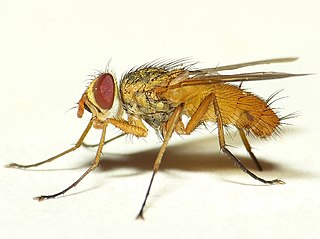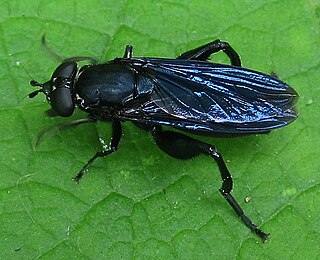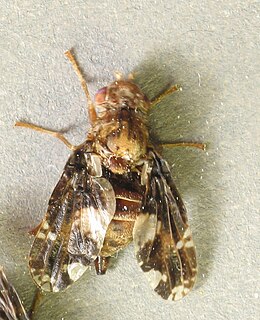
Johann Wilhelm Meigen was a German entomologist famous for his pioneering work on Diptera.
Christian Rudolph Wilhelm Wiedemann was a German physician, historian, naturalist and entomologist. He is best known for his studies of world Diptera, but he also studied Hymenoptera and Coleoptera, although far less expertly.

The Dryomyzidae are a small family of flies ranging from 4–18 mm long, with prominent bristles, and yellow to brown or rust-yellow coloring. The wings are very large. The subcosta is complete and well separated from vein 1. Larvae feed on decaying organic matter - carrion, dung, and fungi. The prelambrum protrudes from the oral cavity. Vibrissae are absent and the postvertical bristles are divergent.

The Pyrgotidae are an unusual family of flies (Diptera), one of only two families of Cyclorrhapha that lack ocelli. Most species are "picture-winged", as is typical among the Tephritoidea, but unlike other tephritoids, they are endoparasitoids; the females pursue scarab beetles in flight, laying an egg on the beetle's back under the elytra where the beetle cannot reach it. The egg hatches and the fly larva enters the body cavity of the beetle, feeding and eventually killing the host before pupating. In the United States, some species of Pyrgota and Sphecomyiella can be quite common in areas where their host beetles are abundant. Like their host beetles, these flies are primarily nocturnal, and are often attracted to artificial lights.

Leskia is a genus of flies in the family Tachinidae.
Metasphenisca is a genus of tephritid or fruit flies in the family Tephritidae.

Chalcosyrphus is a genus of hoverflies in the subfamily Eristalinae. Many species exhibit some degree of mimicry of various sawflies and other hymenopterans and are often brightly coloured or metallic in hue. The adults are similar in structure and behavior to the related genus Xylota but differ in larval morphology. They can be found throughout Europe, Asia, North America and South America and seem to prefer damper, boggy habitats. The larvae are saproxylic feeders in rotten wood in these habitats.

Gonia is a genus of flies in the family Tachinidae.

Betasyrphus is a genus of hoverfly.

The Ropalomeridae are a family of acalyptrate flies.

Eurosta is a genus of gall maker flies in the family Tephritidae. There are seven species in the genus, all in North America.

Empidinae are a subfamily of empidoid flies. They are mainly predatory flies like most of their relatives, and generally small to medium-sized. Most species are flower visitors and they can be effective pollinators.

Toxophorinae is a subfamily of bee flies in the family Bombyliidae. There are about 7 genera and more than 400 described species in Toxophorinae.

Chrysopsinae is a subfamily of deer flies in the family Tabanidae. There are about 33 genera and 600 described species in Chrysopsinae.

Wohlfahrtia is a genus of flesh flies in the family Sarcophagidae. There are at least 20 described species in Wohlfahrtia.
Amphicnephes is a genus of signal flies in the family Platystomatidae. There are at least three described species in Amphicnephes.

Ulidiini is a tribe of picture-winged flies in the family Ulidiidae that live in the arid and sub arid regions of the Palaearctic. There are three genera and around 100 species within the tribe. The tribe was first named in 1835; its type genus is Ulidia.
Macrostomus is a genus of flies in the family Empididae.














